In July 2014, President Obama signed the Huna Tlingit Traditional Gull Egg Use Act (P.L. 113-142) into law marking an important step in a long journey to authorize the harvest of glaucous-winged gull eggs by the Huna Łingít in their traditional Homeland of Glacier Bay National Park (Figure 1). The science behind the law - both ethnographic and biological - stretches long into the past and will presumably continue long into the future (Figure 2).
Gathering eggs in Glacier Bay was something especially the family looked forward to. It was like Easter. Family and cousins gathered up there and we collected eggs, and it was a joyous occasion. Huna Łingít elder
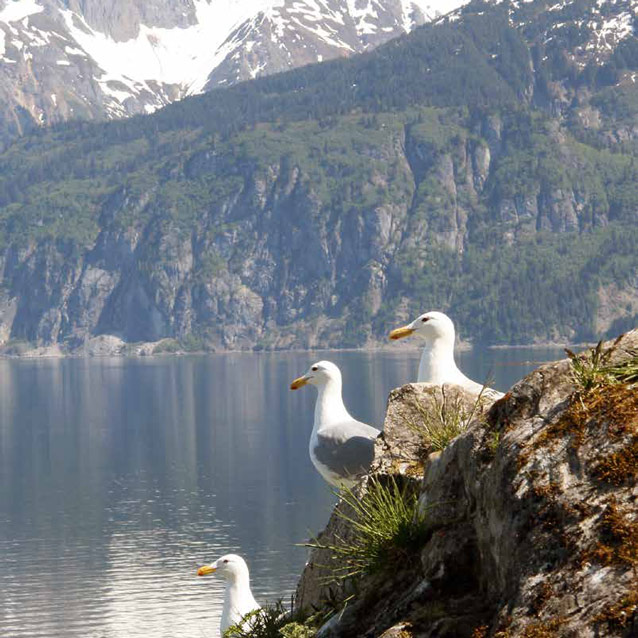
Mary Beth Moss
Egg Harvesting Traditions
For centuries, the Huna Łingít harvested gull eggs at rookeries scattered throughout the recently delgaciated islands of lower Glacier Bay. While gull eggs never comprised a major portion of the traditional Łingít diet, they were nonetheless a prized spring food source for the Huna people. Family harvest trips once served as an important mechanism for maintaining ties with homeland and transmitting stories, moral codes and cultural traditions to the younger generations (Hunn et al. 2002). The period from mid-May to mid-June is called "Going to Get Eggs Moon" in the Huna Łingít calendar, signifying the importance of this activity during the late spring and early summer (Figure 3).
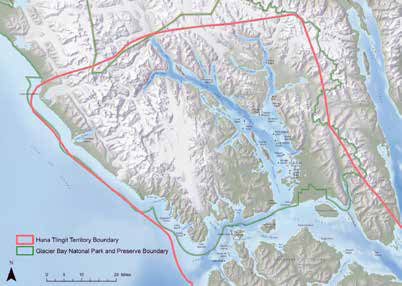
For traditional people, the first spring harvests of gull eggs mark the transition from a season of confinement, scarcity, and reliance on stored foods to a season of activity, abundance, fresh foods, and good travel weather. Harvests typically involved the whole family, providing a unique opportunity for children to learn from their parents, grandparents, and extended family—in the context of an actual harvest activity—both practical and moral lessons. Such trips may have been the first opportunity Tlingit children had to experience the self-esteem that comes from successfully gathering and sharing foodstuffs.
Traditional harvest at Glacier Bay rookeries likely began as early as glacial retreat created suitable gull nesting habitat in the lower bay (perhaps the mid-1800s) and continued well into the mid-twentieth century. Members of the 1889 Harriman expedition were treated to a meal that included gull eggs (Goetzmann and Sloan 1982) and early National Park Service (NPS) representatives described egg harvest practices occurring in the bay (Traeger 1939; Been 1940). Throughout the 1940s, 1950s and early 1960s, NPS policy toward this traditional use was "to permit the Indians [sic] to take hair seals and to collect gull eggs and berries as they have done in the past until a definite wildlife policy can be determined." By 1965, however, the NPS began enforcing the Migratory Bird Act and related NPS regulations and policies, which prohibited egg harvest. The eventual enforcement of these laws and regulations strained relationships between the Huna Tlingit and the NPS. While some level of harvest continued at rookeries outside of park boundaries, the Huna Tlingit longed for the opportunity to return to rookeries on the islands that dot lower Glacier Bay called K’wát’ Aaní, the Land that Belongs to the Seagull Eggs. Harvest centered on these islands for many reasons: they were relatively close to permanent settlements; the calm waters and comparatively gentle shores of Glacier Bay allowed easy access for elders and youth in spring; rookeries in these “inside waters” were thought to produce eggs earlier than rookeries in Icy Strait or outer waters; and the productive, pristine waters of Glacier Bay are thought to produce particularly tasty, pure, and rich eggs.
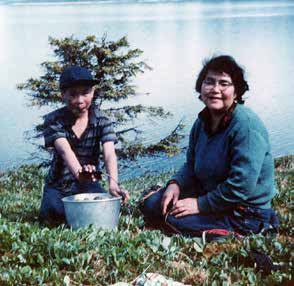
Courtesy of the Mills family
Glaucous-winged Gulls
Glaucous-winged gulls (Larus glaucescens) are common in southeast Alaska throughout the year and begin nesting in Glacier Bay as early as mid to late May (Patten 1974; Zador 2001). They typically lay three eggs per clutch and will often replace eggs lost to harvest, predation, or natural events such as flooding until the clutches are complete (Brown and Morris 1996). Under the aegis of John Piatt of the U.S. Geological Survey (USGS), graduate student Stephanie Zador studied the potential effects of human harvest as well as predation on the glaucous-winged gull population nesting on South Marble Island in Glacier Bay. Using ethnographic data collected by Hunn and others (2002), Zador simulated a traditional harvest and developed population models based on observed parameters (Zador 2001; Zador and Piatt 1999 and 2002; Zador et al. 2006). Zador’s model concluded that egg harvest would have little impact on the reproductive success of gulls if infrequent harvests occur early in the laying season (Figures 4 and 5).
Legislative Environmental Impact Statement
Following a 1997 meeting, NPS and the Hoonah Indian Association (HIA, the federally recognized tribal government) agreed to focus energy on a range of programs designed to encourage and reinvigorate cultural activities within the park, including the traditional harvest of gull eggs. Glacier Bay staff identified the need for both ethnographic and biological data to inform the preparation of an Environmental Impact Statement and collaborated with ethnologists through the Pacific Northwest Cooperative Ecosystem Studies Unit and biologists at USGS to acquire both. Section 4 of the Glacier Bay National Park Resource Management Act of 2000 further directed the NPS to determine whether customary egg harvest practices could be authorized in the park.
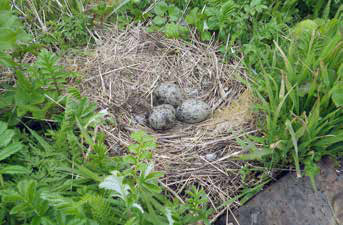
Tania Lewis
Zador and Piatt’s results as well as Hunn and others’ ethnographic study guided NPS’s development of the preferred alternative in a 2010 Legislative Environmental Impact Statement (LEIS) which determined that egg harvest could occur within the park without impacting gull populations or other park resources. The LEIS Record of Decision (ROD) outlined an alternative that would authorize egg harvest at up to five nesting locations in Glacier Bay with a first harvest occurring within five days of the onset of laying and a second harvest occurring within nine days of the first. Harvests could not take place after June 15 to maximize gulls reproductive success by allowing adequate time for relaying after harvest.
The gull harvest LEIS ROD also specifically mandates that NPS monitor gull colonies to inform decision making and mitigate potential negative effects of the harvest. Yearly monitoring requirements include (1) identifying the onset of laying, (2) determining breeding colony size, (3) determining number of eggs in nests during harvest, (4) determining number of eggs available for harvest or hatching, and (5) documenting other bird and marine mammal species present that may be impacted by harvest activities. Harvest sites are to be selected based on the colony size (with larger colonies preferred as harvest locations); population parameters including productivity, population status, recent egg harvest, and age of colony; and whether other species are present or not.
Monitoring Methods
To fulfill the LEIS ROD requirements, Glacier Bay resource management staff monitored glaucous-winged gulls in 2012, 2013, and 2014. We conducted ground surveys consisting of a full census of harvestable nests and nest contents mid-incubation (early June). We surveyed each site at least once during incubation to determine the maximum number of eggs available for harvest or hatching. Two trained observers conducted surveys by quickly moving through the colony while taking care not to step on nests or eggs. To minimize impacts to incubating eggs, we did not conduct surveys on cold rainy days and terminated surveys when the first hatchling was observed at each location to minimize disturbance and chick mortality. We classified eggs as predated when we observed broken egg fragments with consumed contents (Figure 6).
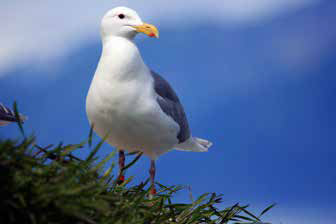
Christopher Behnke
Results
We conducted repeat vessel and ground surveys from May 20 to August 21 of 2012, 2013, and 2014. We documented over 1,100 glaucous-winged gulls at seven rookeries, ranging from seven to 144 harvestable nests per colony (Figure 7). Although the number of nests at each colony remained relatively stable through time, we found a substantial difference in productivity as evidenced by the number of eggs and fledglings between 2012, 2013 and 2014 (Figure 8). In 2012, we observed a total of 187 eggs in 672 nests (0.28 eggs per nest) and only one hatched chick in all colonies combined. In 2013, we observed 1403 eggs in 664 nests (2.11 eggs per nest) and 437 hatched chicks in all colonies. In 2014, we observed 904 eggs in 366 nests (2.47 eggs per nest) and 67 hatched chicks in all colonies.
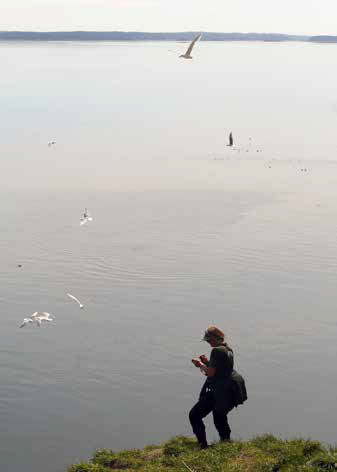
NPS Photo
The mean number of adult gulls during mid-laying season (June 15 to July 15) across the three years varied by colony from a low of 45 at Tlingit Point to a high of 586 at South Marble Island with Boulder and Lone Islands exhibiting the greatest variance between years (Figure 9). It is important to note that the number of chicks/fledglings observed during the vessel surveys represent a larger nesting area than that of the nests and eggs counted during the ground surveys because terrain and marine mammals limit access to portions of several colonies for ground surveys (Figures 7, 8 and 9).
Hauled-out harbor seals (Phoca vitulina richardii), sea otters (Enhydra lutris), and Steller sea lions (Eumetopias jubatus), which are protected under the Marine Mammal Protection Act (and for Steller sea lions the Endangered Species Act), prevented surveys to multiple rookeries on multiple visits. These species may be vulnerable to disturbance during egg harvest at several locations. Nesting seabirds that may be disturbed by harvest include black oystercatchers (Haematopus bachmani), Arctic terns (Sterna paradisaea), pigeon guillemots (Cepphus columba), mew gulls (Larus canus), Canada geese (Branta Canadensis), and Caspian terns (Hydroprogne caspia) (Figure 10).
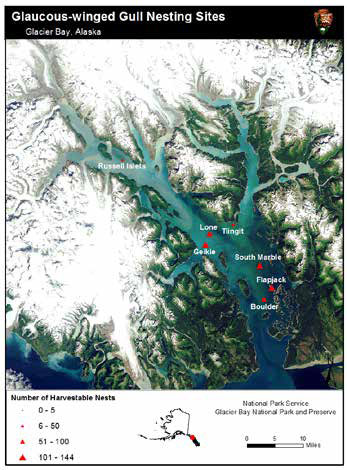
Next Steps
These monitoring results suggest considerable variation between years and nesting sites in the number of eggs that might be available for harvest. Importantly, gull nesting distribution at traditional harvest sites such as South Marble Island appears to have declined, presumably as a result of vegetative successional processes that reduce the suitability of habitat.
We also suspect from anecdotal observations, that egg predation on South Marble Island has increased in recent years, perhaps due to the increased availability of large trees used as predator perches (Figure 11). In addition, several potential harvest locations now support large numbers of hauled-out marine mammals, which may preclude access by harvesters.

With the long-awaited passage of the gull egg legislation, NPS can now promulgate the necessary regulations to implement the law. Meanwhile, a collaborative working group comprised of NPS staff and tribal members have begun meeting to discuss the practicalities of implementing harvests in the park, brainstorming various solutions to logistical challenges. Group discussions will inform the development of the annual harvest plans required by the LEIS.
Within the next several years, Huna Tlingit will once again be able to legally harvest gull eggs in Glacier Bay for the first time in over 50 years. Although it has been more than 18 years since NPS and HIA began the conversation about reauthorizing gull egg harvest, the long process itself has served to heal strained relationships and strengthen our partnership. By combining western and traditional sciences; committing to open and honest dialog; and agreeing to respect our diverse, sometimes divergent, traditions and approaches, the National Park Service and a tribal community are collaboratively stewarding resources we are both mandated to protect and preserve.
Acknowledgements
The National Park Service provided financial and logistical support for this project. Many thanks to: C. Behnke, S. Boudreau, T. Bruno, L. Etherington, L. Fano, P. Hooge, F. Koschmann, K. Mocnik, J. Saracco, J. Smith, J. Womble, S. Zador, the Hoonah Indian Association, Huna elders, and to the glaucous-winged gulls of Glacier Bay. This research project was permitted by the NPS, the Alaska Department of Fish and Game, and the U.S. Fish and Wildlife Service.
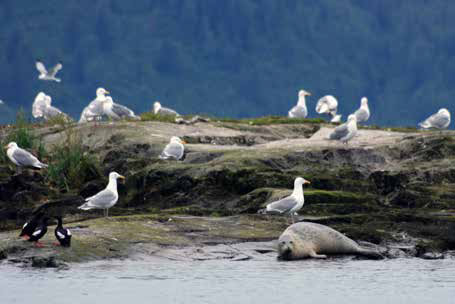
Christopher Behnke
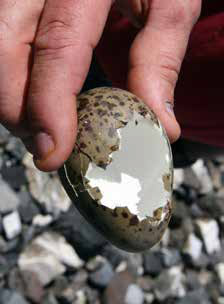
Mary Beth Moss
References
Allen, C., J. Fontaine, K. Pope, and A. Garmestani. 2011.
Adaptive management for a turbulent future. Journal of Environmental Management. 92: 1339-1345.
Been, F. 1940.
Notes taken in the field during inspection of Admiralty Island, Sitka National Monument and Glacier Bay National Monument, July 8 to August 17, 1940 (in the company of Victor Cahalane Fish and Wildlife Service). Typescript of daily log. McKinley Park, Alaska.
Brown K., and R. Morris. 1996.
From tragedy to triumph: re-nesting in ring-billed gulls. The Auk. 113(1):23-31.
Goetzmann, W., and K. Sloan. 1982.
Looking far north: the Harriman Expedition to Alaska, 1899. Princeton: Princeton Univ. Press.
Hunn E., D. Johnson, P. Russell, and T. Thornton. 2002.
A study of traditional use of birds’ eggs by the Huna Tlingit. Gustavus, AK: National Park Service.
National Park Service Glacier Bay National Park and Preserve. 2010.
Harvest of glaucous-winged gull eggs by Huna Tlingit in Glacier Bay National Park. Legislative environmental impact statement.
Patten, S. 1974.
Breeding ecology of the glaucous-winged gull (Larus glausescens) in Glacier Bay, Alaska. M.Sc. thesis. Seattle: University of Washington.
Tear, T. et al. 2005.
How much is enough? The recurrent problem of setting measurable objectives in conservation. Bioscience. 55(10): 835-849.
Trager, E. 1939.
Glacier Bay expedition, 1939. File report. NAPSR RG79. Western Region, central classified files, Box 293.
Zador, S. and J. Piatt. 1999.
Populations and productivity of seabirds at South Marble Island, Glacier Bay, Alaska, during May-July 1999. USGS Biological Resource Division and University of Washington College of Forest Resources.
Zador, S., 2001.
Reproductive and physiological consequences of egg predation for glaucous-winged gulls. M.Sc. thesis. Seattle: University of Washington.
Zador, S. and J. Piatt. 2002.
Simulating the effects of predation and egg-harvest at a gull colony. Eds. J. Piatt, and S. Gende. Proceedings of the Fourth Glacier Bay Science Symposium.
Zador, S., J. Piatt, and A. Punt. 2006.
Balancing predation and egg harvest in a colonial seabird: a simulation model. Ecological Modeling. 195:318-326.
Part of a series of articles titled Alaska Park Science - Volume 14 Issue 2: Birds of Alaska's National Parks.
Last updated: April 21, 2025
